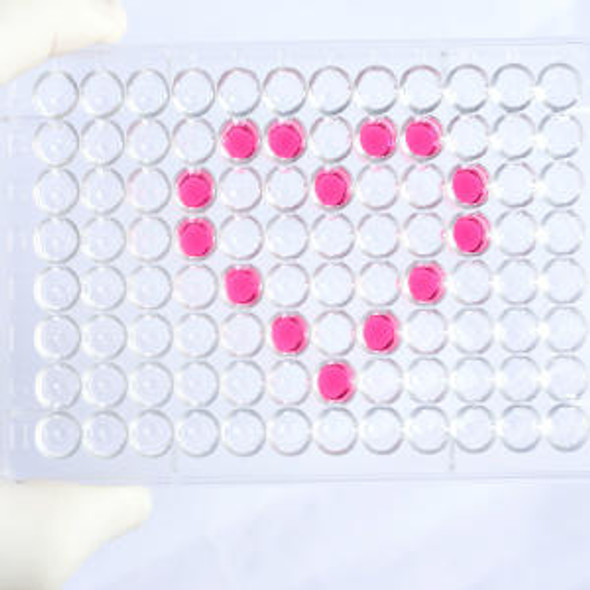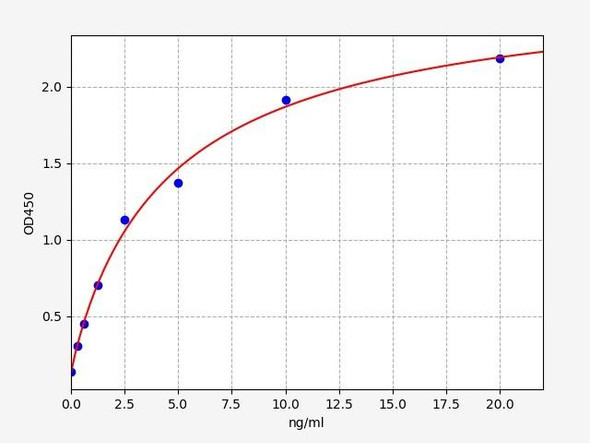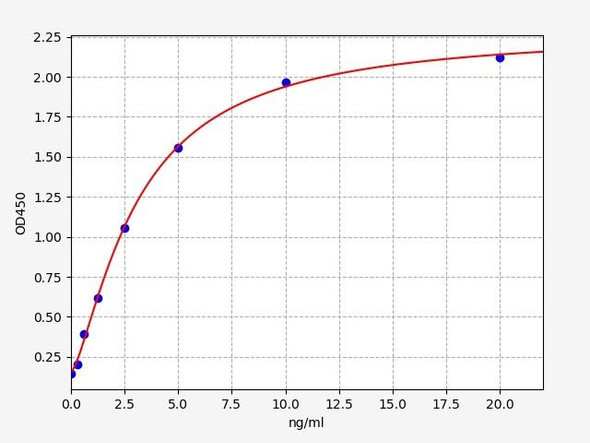Human WNT7A ELISA Kit
- SKU:
- HUFI01969
- Product Type:
- ELISA Kit
- Size:
- 96 Assays
- Uniprot:
- O00755
- Sensitivity:
- 18.75pg/ml
- Range:
- 31.25-2000pg/ml
- ELISA Type:
- Sandwich ELISA, Double Antibody
- Synonyms:
- WNT7A
- Reactivity:
- Human
Description
| Product Name: | Human WNT7A ELISA Kit |
| Product Code: | HUFI01969 |
| Size: | 96 Assays |
| Alias: | WNT7A |
| Detection method: | Sandwich ELISA, Double Antibody |
| Application: | This immunoassay kit allows for the in vitro quantitative determination of Human WNT7A concentrations in serum plasma and other biological fluids. |
| Sensitivity: | 18.75pg/ml |
| Range: | 31.25-2000pg/ml |
| Storage: | 4°C for 6 months |
| Note: | For Research Use Only |
| Recovery: | Matrices listed below were spiked with certain level of Human WNT7A and the recovery rates were calculated by comparing the measured value to the expected amount of Human WNT7A in samples. | ||||||||||||||||
| |||||||||||||||||
| Linearity: | The linearity of the kit was assayed by testing samples spiked with appropriate concentration of Human WNT7A and their serial dilutions. The results were demonstrated by the percentage of calculated concentration to the expected. | ||||||||||||||||
| |||||||||||||||||
| CV(%): | Intra-Assay: CV<8% Inter-Assay: CV<10% |
| Component | Quantity | Storage |
| ELISA Microplate (Dismountable) | 8×12 strips | 4°C for 6 months |
| Lyophilized Standard | 2 | 4°C/-20°C |
| Sample/Standard Dilution Buffer | 20ml | 4°C |
| Biotin-labeled Antibody(Concentrated) | 120ul | 4°C (Protect from light) |
| Antibody Dilution Buffer | 10ml | 4°C |
| HRP-Streptavidin Conjugate(SABC) | 120ul | 4°C (Protect from light) |
| SABC Dilution Buffer | 10ml | 4°C |
| TMB Substrate | 10ml | 4°C (Protect from light) |
| Stop Solution | 10ml | 4°C |
| Wash Buffer(25X) | 30ml | 4°C |
| Plate Sealer | 5 | - |
Other materials and equipment required:
- Microplate reader with 450 nm wavelength filter
- Multichannel Pipette, Pipette, microcentrifuge tubes and disposable pipette tips
- Incubator
- Deionized or distilled water
- Absorbent paper
- Buffer resevoir
| Uniprot | O00755 |
| UniProt Protein Function: | WNT7A: Ligand for members of the frizzled family of seven transmembrane receptors. Probable developmental protein. Signaling by Wnt-7a allows sexually dimorphic development of the mullerian ducts. Defects in WNT7A are the cause of limb pelvis hypoplasia aplasia syndrome (LPHAS). A syndrome of severe deficiency of the extremities due to hypo- or aplasia of one or more long bones of one or more limbs. Pelvic manifestations include hip dislocation, hypoplastic iliac bone and aplastic pubic bones. Thoracic deformity, unusual facies and genitourinary anomalies can be present. Defects in WNT7A are a cause of Fuhrmann syndrome (FUHRS); also known as fibular aplasia or hypoplasia femoral bowing and poly- syn- and oligodactyly. Fuhrmann syndrome is a distinct limb-malformation disorder characterized also by various degrees of limb aplasia/hypoplasia and joint dysplasia. Belongs to the Wnt family. |
| UniProt Protein Details: | Protein type:Secreted; Secreted, signal peptide Chromosomal Location of Human Ortholog: 3p25 Cellular Component: proteinaceous extracellular matrix; extracellular space; cell surface; endoplasmic reticulum lumen; Golgi lumen; plasma membrane; extracellular region Molecular Function:frizzled binding; cytokine activity; receptor agonist activity; receptor binding Biological Process: embryonic forelimb morphogenesis; somatic stem cell maintenance; positive regulation of epithelial cell proliferation involved in wound healing; cell proliferation in forebrain; neurotransmitter secretion; positive regulation of transcription, DNA-dependent; positive regulation of JNK cascade; Wnt receptor signaling pathway through beta-catenin; palate development; embryonic hindlimb morphogenesis; response to estradiol stimulus; negative regulation of neurogenesis; neuron differentiation; central nervous system vasculogenesis; regulation of axon diameter; synapse organization and biogenesis; somatic stem cell division; chondrocyte differentiation; satellite cell activation; angiogenesis; fallopian tube development; cartilage condensation; cell fate commitment; embryonic axis specification; satellite cell compartment self-renewal involved in skeletal muscle regeneration; cerebellar granule cell differentiation; asymmetric protein localization; positive regulation of synaptogenesis; stem cell development; dorsal/ventral pattern formation; establishment of cell polarity; positive regulation of transcription from RNA polymerase II promoter; embryonic digit morphogenesis; sex differentiation; negative regulation of apoptosis Disease: Ulna And Fibula, Absence Of, With Severe Limb Deficiency; Fibular Aplasia Or Hypoplasia, Femoral Bowing And Poly-, Syn-, And Oligodactyly |
| NCBI Summary: | This gene is a member of the WNT gene family, which consists of structurally related genes that encode secreted signaling proteins. These proteins have been implicated in oncogenesis and in several developmental processes, including regulation of cell fate and patterning during embryogenesis. This gene is involved in the development of the anterior-posterior axis in the female reproductive tract, and also plays a critical role in uterine smooth muscle pattering and maintenance of adult uterine function. Mutations in this gene are associated with Fuhrmann and Al-Awadi/Raas-Rothschild/Schinzel phocomelia syndromes. [provided by RefSeq, Jul 2008] |
| UniProt Code: | O00755 |
| NCBI GenInfo Identifier: | 145559540 |
| NCBI Gene ID: | 7476 |
| NCBI Accession: | O00755.2 |
| UniProt Secondary Accession: | O00755,Q96H90, Q9Y560, |
| UniProt Related Accession: | O00755 |
| Molecular Weight: | 349 |
| NCBI Full Name: | Protein Wnt-7a |
| NCBI Synonym Full Names: | wingless-type MMTV integration site family, member 7A |
| NCBI Official Symbol: | WNT7A |
| NCBI Protein Information: | protein Wnt-7a; proto-oncogene Wnt7a protein |
| UniProt Protein Name: | Protein Wnt-7a |
| UniProt Gene Name: | WNT7A |
| UniProt Entry Name: | WNT7A_HUMAN |
*Note: Protocols are specific to each batch/lot. For the correct instructions please follow the protocol included in your kit.
Before adding to wells, equilibrate the SABC working solution and TMB substrate for at least 30 min at 37°C. When diluting samples and reagents, they must be mixed completely and evenly. It is recommended to plot a standard curve for each test.
| Step | Protocol |
| 1. | Set standard, test sample and control (zero) wells on the pre-coated plate respectively, and then, record their positions. It is recommended to measure each standard and sample in duplicate. Wash plate 2 times before adding standard, sample and control (zero) wells! |
| 2. | Aliquot 0.1ml standard solutions into the standard wells. |
| 3. | Add 0.1 ml of Sample / Standard dilution buffer into the control (zero) well. |
| 4. | Add 0.1 ml of properly diluted sample ( Human serum, plasma, tissue homogenates and other biological fluids.) into test sample wells. |
| 5. | Seal the plate with a cover and incubate at 37 °C for 90 min. |
| 6. | Remove the cover and discard the plate content, clap the plate on the absorbent filter papers or other absorbent material. Do NOT let the wells completely dry at any time. Wash plate X2. |
| 7. | Add 0.1 ml of Biotin- detection antibody working solution into the above wells (standard, test sample & zero wells). Add the solution at the bottom of each well without touching the side wall. |
| 8. | Seal the plate with a cover and incubate at 37°C for 60 min. |
| 9. | Remove the cover, and wash plate 3 times with Wash buffer. Let wash buffer rest in wells for 1 min between each wash. |
| 10. | Add 0.1 ml of SABC working solution into each well, cover the plate and incubate at 37°C for 30 min. |
| 11. | Remove the cover and wash plate 5 times with Wash buffer, and each time let the wash buffer stay in the wells for 1-2 min. |
| 12. | Add 90 µl of TMB substrate into each well, cover the plate and incubate at 37°C in dark within 10-20 min. (Note: This incubation time is for reference use only, the optimal time should be determined by end user.) And the shades of blue can be seen in the first 3-4 wells (with most concentrated standard solutions), the other wells show no obvious color. |
| 13. | Add 50 µl of Stop solution into each well and mix thoroughly. The color changes into yellow immediately. |
| 14. | Read the O.D. absorbance at 450 nm in a microplate reader immediately after adding the stop solution. |
When carrying out an ELISA assay it is important to prepare your samples in order to achieve the best possible results. Below we have a list of procedures for the preparation of samples for different sample types.
| Sample Type | Protocol |
| Serum | If using serum separator tubes, allow samples to clot for 30 minutes at room temperature. Centrifuge for 10 minutes at 1,000x g. Collect the serum fraction and assay promptly or aliquot and store the samples at -80°C. Avoid multiple freeze-thaw cycles. If serum separator tubes are not being used, allow samples to clot overnight at 2-8°C. Centrifuge for 10 minutes at 1,000x g. Remove serum and assay promptly or aliquot and store the samples at -80°C. Avoid multiple freeze-thaw cycles. |
| Plasma | Collect plasma using EDTA or heparin as an anticoagulant. Centrifuge samples at 4°C for 15 mins at 1000 × g within 30 mins of collection. Collect the plasma fraction and assay promptly or aliquot and store the samples at -80°C. Avoid multiple freeze-thaw cycles. Note: Over haemolysed samples are not suitable for use with this kit. |
| Urine & Cerebrospinal Fluid | Collect the urine (mid-stream) in a sterile container, centrifuge for 20 mins at 2000-3000 rpm. Remove supernatant and assay immediately. If any precipitation is detected, repeat the centrifugation step. A similar protocol can be used for cerebrospinal fluid. |
| Cell culture supernatant | Collect the cell culture media by pipette, followed by centrifugation at 4°C for 20 mins at 1500 rpm. Collect the clear supernatant and assay immediately. |
| Cell lysates | Solubilize cells in lysis buffer and allow to sit on ice for 30 minutes. Centrifuge tubes at 14,000 x g for 5 minutes to remove insoluble material. Aliquot the supernatant into a new tube and discard the remaining whole cell extract. Quantify total protein concentration using a total protein assay. Assay immediately or aliquot and store at ≤ -20 °C. |
| Tissue homogenates | The preparation of tissue homogenates will vary depending upon tissue type. Rinse tissue with 1X PBS to remove excess blood & homogenize in 20ml of 1X PBS (including protease inhibitors) and store overnight at ≤ -20°C. Two freeze-thaw cycles are required to break the cell membranes. To further disrupt the cell membranes you can sonicate the samples. Centrifuge homogenates for 5 mins at 5000xg. Remove the supernatant and assay immediately or aliquot and store at -20°C or -80°C. |
| Tissue lysates | Rinse tissue with PBS, cut into 1-2 mm pieces, and homogenize with a tissue homogenizer in PBS. Add an equal volume of RIPA buffer containing protease inhibitors and lyse tissues at room temperature for 30 minutes with gentle agitation. Centrifuge to remove debris. Quantify total protein concentration using a total protein assay. Assay immediately or aliquot and store at ≤ -20 °C. |
| Breast Milk | Collect milk samples and centrifuge at 10,000 x g for 60 min at 4°C. Aliquot the supernatant and assay. For long term use, store samples at -80°C. Minimize freeze/thaw cycles. |









